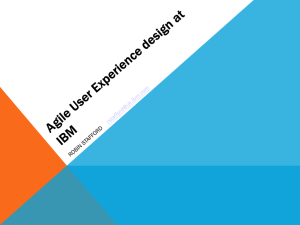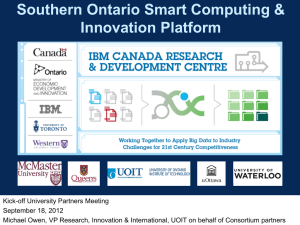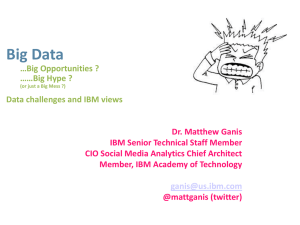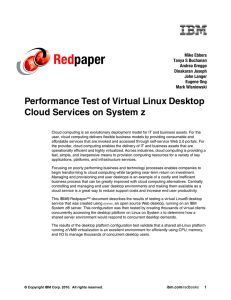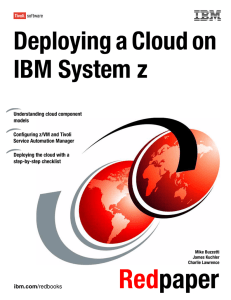Smart Computing R&D Challenge
advertisement
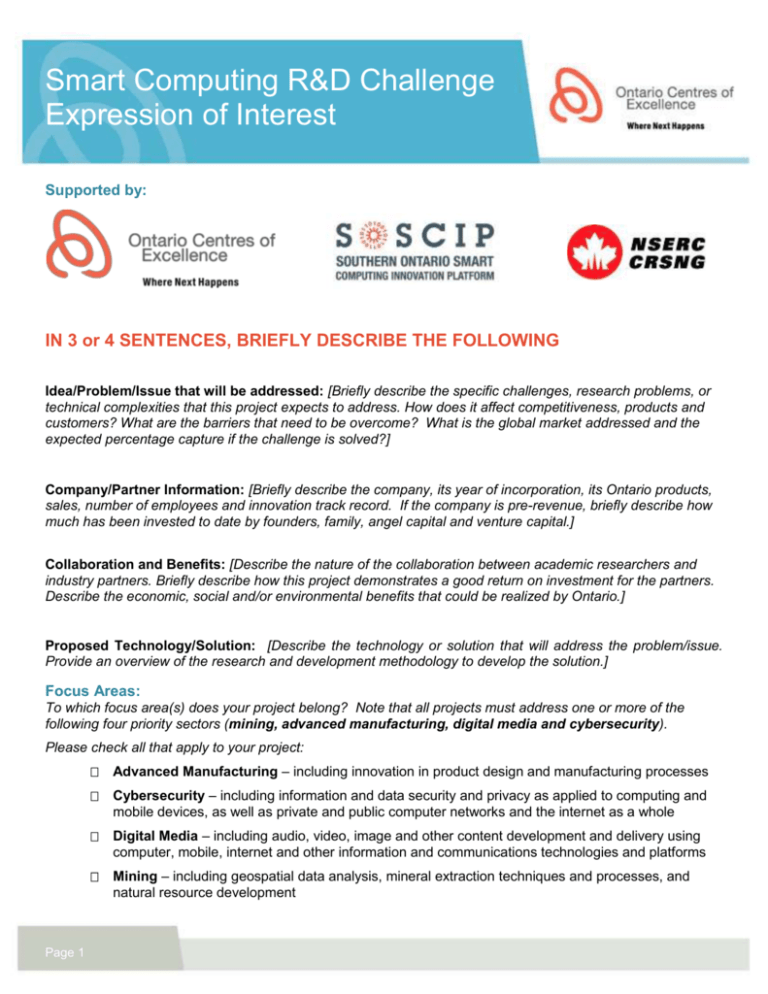
Smart Computing R&D Challenge Expression of Interest Supported by: IN 3 or 4 SENTENCES, BRIEFLY DESCRIBE THE FOLLOWING Idea/Problem/Issue that will be addressed: [Briefly describe the specific challenges, research problems, or technical complexities that this project expects to address. How does it affect competitiveness, products and customers? What are the barriers that need to be overcome? What is the global market addressed and the expected percentage capture if the challenge is solved?] Company/Partner Information: [Briefly describe the company, its year of incorporation, its Ontario products, sales, number of employees and innovation track record. If the company is pre-revenue, briefly describe how much has been invested to date by founders, family, angel capital and venture capital.] Collaboration and Benefits: [Describe the nature of the collaboration between academic researchers and industry partners. Briefly describe how this project demonstrates a good return on investment for the partners. Describe the economic, social and/or environmental benefits that could be realized by Ontario.] Proposed Technology/Solution: [Describe the technology or solution that will address the problem/issue. Provide an overview of the research and development methodology to develop the solution.] Focus Areas: To which focus area(s) does your project belong? Note that all projects must address one or more of the following four priority sectors (mining, advanced manufacturing, digital media and cybersecurity). Please check all that apply to your project: Page 1 Advanced Manufacturing – including innovation in product design and manufacturing processes Cybersecurity – including information and data security and privacy as applied to computing and mobile devices, as well as private and public computer networks and the internet as a whole Digital Media – including audio, video, image and other content development and delivery using computer, mobile, internet and other information and communications technologies and platforms Mining – including geospatial data analysis, mineral extraction techniques and processes, and natural resource development Agile Computing – including the use of FPGA hardware accelerators and tools to facilitate the use of such accelerators via general purpose programming models Cities – including the planning, design, implementation and management of smart urban infrastructure systems Energy – including development, extraction, management, delivery, and smart grid applications Health – Including disease modelling and treatment, healthcare applications, and medical data analysis Water – including management, conservation, and the study of water-related environmental and climate systems Request for Resources: To which computing platform are you requesting access? Please check all that apply. Page 2 Blue Gene/Q (BGQ) Platform – The SOSCIP BGQ, hosted at the University of Toronto’s SciNet high-performance computing facility, is well-suited for large-scale, distributed applications that can use 1,024 cores or more at a time and require low-latency, high-bandwidth communication between processors. The BGQ is a highly dense and energy efficient supercomputer built around a system-on-a-chip compute node with a 16-core 1.6 GHz PowerPC®-based CPU with 16 GB of RAM. The nodes are bundled in groups of 32 into a node board (512 cores), with 16 boards making up a mid-plane (8,192 cores) and two mid-planes per rack—or 16,348 cores and 16 TB of RAM per rack. The compute nodes run a lightweight Linuxbased operating system called CNK. The compute nodes are connected using a custom 5D torus high-speed interconnect. Each rack has 16 I/O nodes that run a full Red Hat Linux OS that manages the compute nodes and mounts the file system. The BGQ at SciNet is a four-rack 65,536-core system capable of 840 Tflops. Cloud Analytics Platform – This platform, based at Western University’s SHARCNET highperformance computing facility, is Canada’s first research-dedicated cloud environment, combining cloud computing with advanced analytics software. It is ideal for complex data analysis, such as statistical weighting and ranking, managing and streamlining large data volumes from multiple sources, and data mining. The Cloud Analytics Platform is based on Virtual Computing Lab open-source cloud technology, provides access to IBM analytics software, including IBM InfoSphere Streams, BigInsights, Cognos, SPSS, as well as other software for use on a variety of operating systems. Agile / FPGA Computing Platform – The first cloud-based agile computing research environment in Canada which uses Field-Programmable Gate Array (FPGA) cards to accelerate software running on high-performance computers. FPGAs can accomplish numerically complex tasks, such as data encryption and physics-based system modeling, and handle big data processing more efficiently and at lower cost than by a CPU alone. Software tools provided include Altera Quartus, and Altera SDK for OpenCL. The Agile Computing Platform with FPGAs provides a one-of-a-kind research tool for investigators developing the next generation of highperformance computing systems and software. Large Memory System (LMS) Platform – The LMS platform, hosted at Queen’s University’s HPCVL facility, is a virtual symmetric multiprocessing (vSMP) environment, aggregating three IBM x86 servers using ScaleMP software into a single virtual system. The primary hardware node consists of four Intel Xeon Processors providing 32-cores at 2.7 GHz with 1.5 TB of RAM. Two secondary hardware nodes consist of four Intel Xeon Processors providing 16-cores at 2.0GHz with 1.5 TB of RAM each. This is presented as a single virtual system and as a 64core, 4.5 TB environment. The network topology of the LMS is a mesh, with each hardware node having a direct-attached QDR Infiniband link to other nodes. SYSTEM OPERATING SYSTEMS COMMERCIAL OPEN SOURCE SOFTWARE SOFTWARE Blue Gene/Q Linux N Cloud Linux, UNIX, Windows Agile Large Memory System LANGUAGES SUPPORT Y C, C++, Python, FORTRAN Y Y All Linux Y Y Java, OpenCL, VHDL Via SciNet (UofT), IBM postdocs Via SHARCNET (Western), IBM postdocs Via SHARCNET (Western), IBM post docs Linux Y Y All Via HPCVL (Queen’s) i. Explain why the chosen platform is appropriate for your computational needs. Outline any previous experience with similar platforms and software. ii. List any commercial/licensed software which is required for this project. Please note that there is no commercial software available on the Blue Gene/Q platform – see the list of installed software on the BGQ for more information. iii. Please estimate the number of core-hours/computing cycles and estimated storage space that you will require. iv. Do you anticipate needing any additional support from technical support staff? If so, please describe your anticipated needs. Risk Analysis and Mitigation: [Outline the key risks and mitigation strategies, including any key dependencies without which the project would not be able to proceed] Commercialization or Business Implementation: [Briefly describe the plans for technology transfer/transfer of intellectual property derived from project and/or commercialization (timing and resources), how it will improve the sector and the company (e.g. new jobs, new products, processes, services, higher productivity, positive environmental and/or social impact).] Outline the opportunities for training and development: [Describe how this project enables the development of our next generation workforce.] Page 3 Page 4 Page 5

